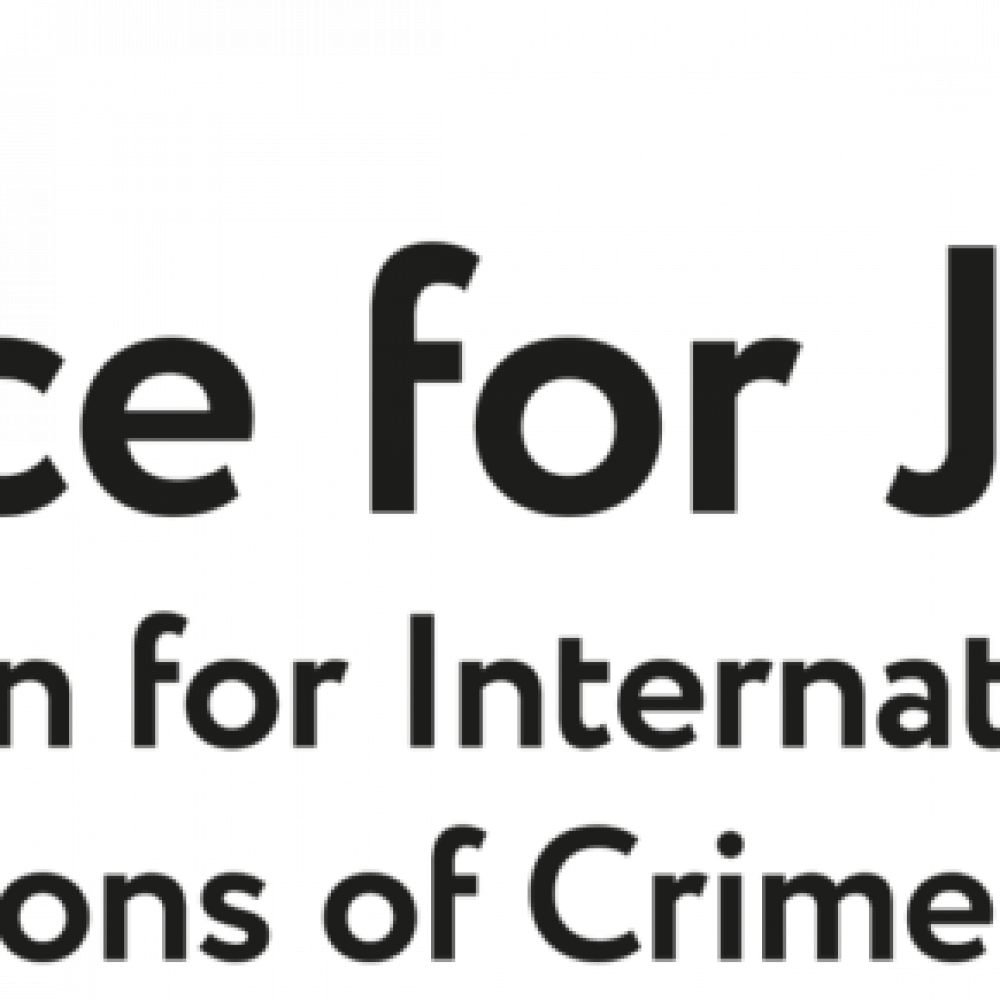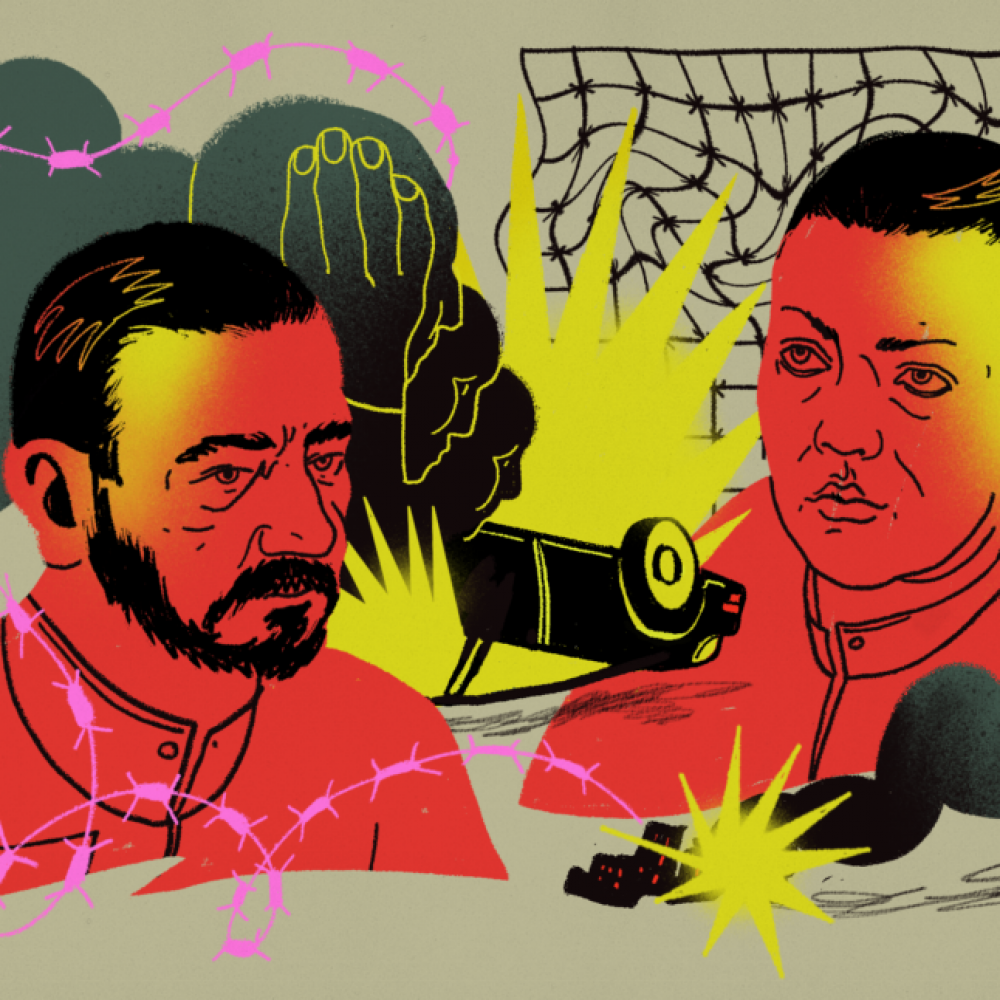The original article is available on the Zaborona website. The investigation is supported by JFJ Investigative Grant Programme.
Important editorial foreword
The murder of journalist Pavel Sheremet is one of the most terrible crimes committed on modern Ukrainian territory, alongside the brutal killing of Georgiy Gongadze, the founder of Ukrayinska Pravda. The explosion in the center of Kyiv not only claimed the life of a famous TV presenter, a brilliant publicist, author of documentaries, and a teacher to many who worked in Ukrainian media. It deprived journalists of a sense of security, and due to the way the police conducted the investigation and tried to limit the penetration of information about him in the media, many developed a distrust of the Ministry of Internal Affairs and the head of the department, Arsen Avakov, in particular. Therefore, we consider it our duty to investigate the murder of our colleague Pavel Sheremet, as well as to put the police work in this case under a microscope.
The Zaborona investigation team analyzed about 6 thousand phone numbers and more than half a million calls in 2016 and partially in 2018-2019, contained in the records of citizens whom the Ministry of Internal Affairs considered either involved in the murder or important for solving the crime. These are phone records, internet data, and other data that mobile operators provide at the request of law enforcement agencies. We also studied all the information from the materials of the criminal case available to us, which the police handed over to the suspects’ lawyers for familiarization.
We came to the conclusion that the investigators formulated charges against the suspects on the basis of their connections with people who know each other, had a criminal past, and skills with explosives. There is no direct evidence in this case. At the same time, there is no mention of the employees of the Security Service of Ukraine who could be related to the surveillance of Sheremet and, possibly, to the planning of his murder.
We were also surprised that during the investigation, the investigators requested some records only at the end of 2019: there are no, for example, reports for 2016 on some of the persons involved from the operators Vodafone and Lifecell. These mobile operators told the Interior Ministry that the data storage period – 3 years – has already expired. Therefore, for some of the people involved, we were only able to analyze Kyivstar’s data. We believe that the lost records could contain phone numbers of people that the police did not want to “stand out”. Information about this could shed light on any other information hidden from the public.
In addition, the selective approach to verification of testimony that the police employed in other episodes of the investigation (for example, the one that we described in two parts of our previous investigation) is not credible. Nor is the Ministry of Internal Affairs’ promise to look into a new version of events voiced by Igor Makar, the former deputy commander of the Belarusian special anti-terrorism unit “Almaz”.
Now it looks like the police have already appointed the perpetrators and will not deviate from the version announced at the briefing in December 2019. We demand a more thorough investigation of the murder of our colleague and verification of all the facts from the Ministry of Internal Affairs.
In the case of the murder of journalist Pavel Sheremet, there are two questionable people about whom little is known to the public, although the Interior Ministry calls them accomplices in the crime. They are Inna and Vladyslav Gryshchenko. Zaborona journalists, together with independent journalist Leonid Ragozin, conducted an investigation and found out that they are part of a network that connects criminals to the security forces and the top leadership of Ukraine. Read in our investigation about who these people are and how they ended up in the Pavel Sheremet murder case.
More than a year has passed since the arrest of the suspects in the murder of journalist Pavel Sheremet, but there is still no clarity about their role or the degree of their involvement. ATO volunteers Yana Dugar, Andriy Antonenko, and Yulia Kuzmenko, arrested in December 2019, are set to stand trial. Antonenko has been in jail all this time, the rest are under house arrest.
“We consider them only performers who were inspired by their curators,” said Anton Gerashchenko, the deputy minister of Internal Affairs in an interview with RBC-Ukraine.

The investigators also named Inna and Vladislav Gryshchenko as suspects, although no one has formally announced suspicion against them so far. The head of the criminal police, Yevgen Koval, said that all five were the perpetrators of Sheremet’s murder. And Gerashchenko said that the silence of the Gryshchenko couple prevents the investigators from finding the alleged “curators”.
“We do not work with the same methods as in Kaharlyk [this is a well-known incident with torture at the police station]. If they worked, then “Puma” and “Bucha” would have told us everything long ago,” Gerashchenko said.
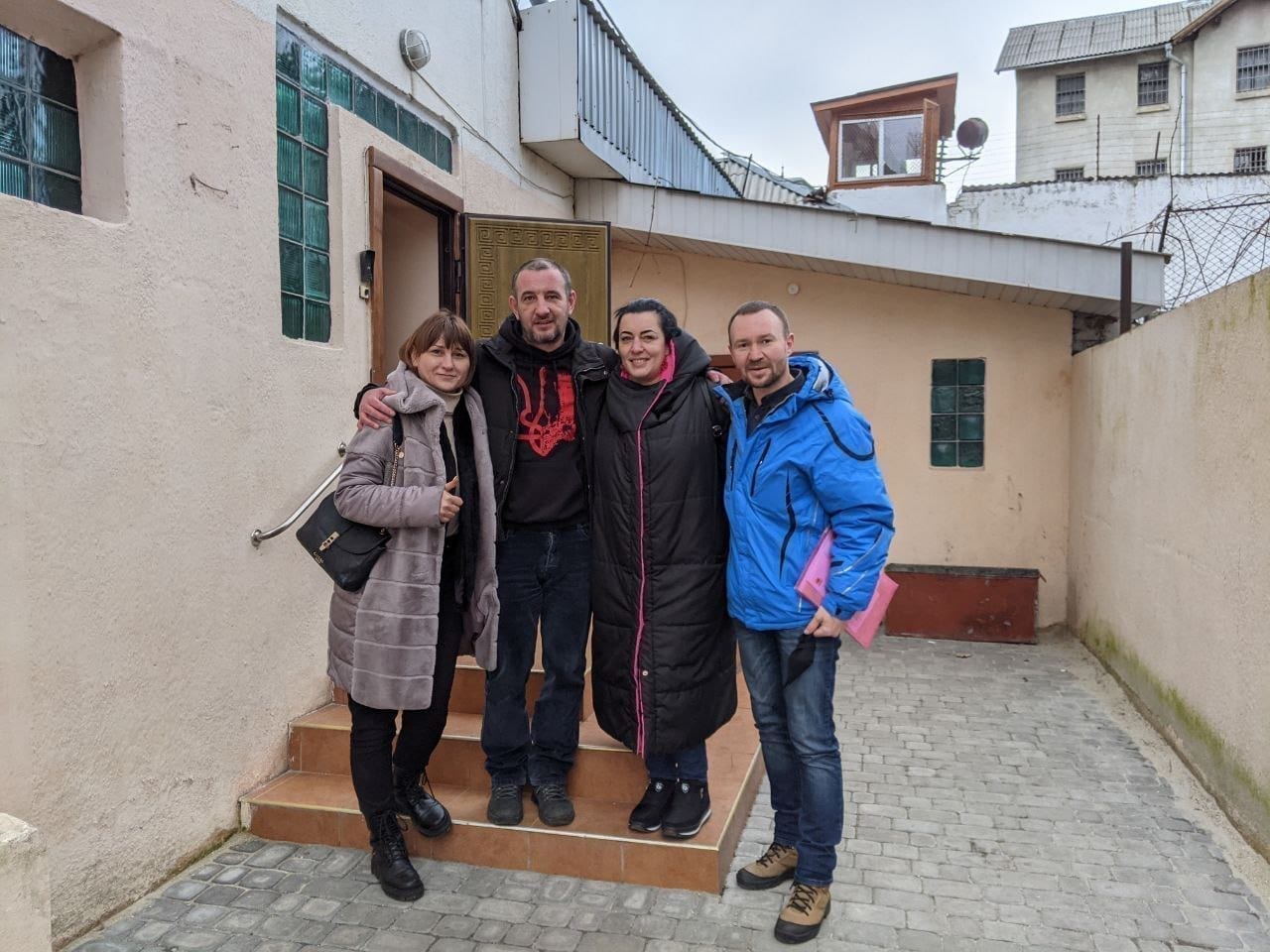
“Bucha” from Bucha, “Puma” from the pre-trial detention center
“Puma” is the call sign of Inna Gryshchenko, and “Bucha” is her husband Vladyslav Gryshchenko. He received his nickname in the Buchansky penal colony. Until January 2014, Inna Gryshchenko worked in the Buchansky penal colony and the Lukyanovsky pre-trial detention center, and after being fired she went to fight at the front. Instead of the official armed forces, she chose the unregistered Ukrainian Volunteer Corps (AUK) “Right Sector”.
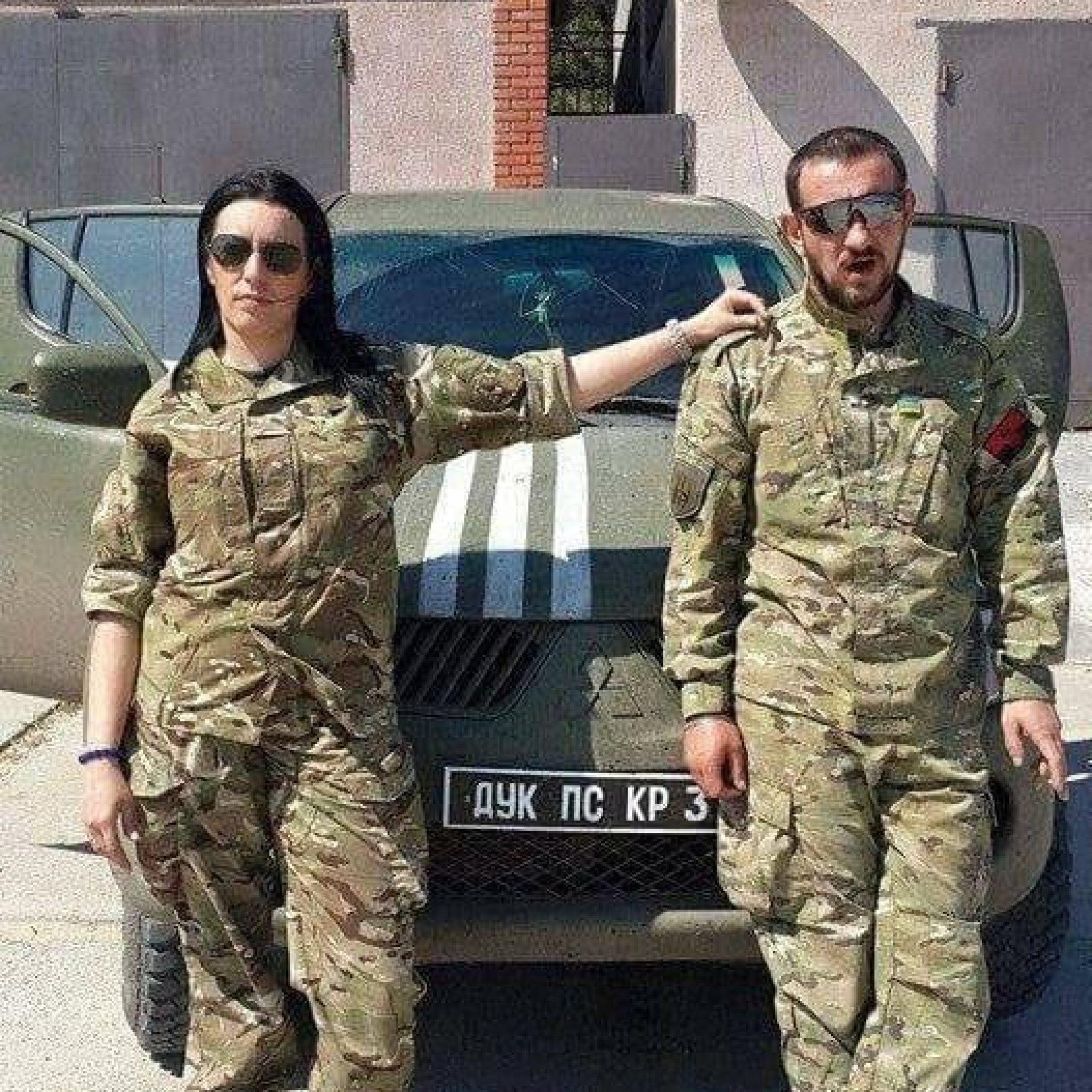
“The fact is that realizing the state of our army at that time, I definitely didn’t want to go there,” explains “Puma” in an interview with Zaborona. “We needed freedom of action. The attitude in the Right Sector DUK was absolutely normal. It was strange there, but [there were] a lot of former law enforcement officers. There were opera singers, investigators, and SBU officers who had special knowledge.”
Unlike other suspects, Inna’s husband Vlad Gryshchenko is not only a repeat offender who has been convicted of serious crimes five times, but also an explosives specialist who does not hide his skills. His wife confirmed to Zaborona that he is a minesweeper. A bomb exploded in Pavel Sheremet’s car, killing him.
The case in Petropavlovka
Vlad Gryshchenko is a professional killer. He himself admitted this in October 2017 in a piece on ICTV, dedicated to his loudest case, which unfolded during the same period as the murder of Sheremet.
According to the official version made public by the police, in June 2016 Petro Genyk, a farmer from the Dnipropetrovsk region, came to Gryshchenko. He offered 30 thousand dollars for the murder of another farmer, Vladimir Zorenko (though in the story Zorenko says about 40 thousand). At that time, Gryshchenko was listed as a minesweeper in the 95th airmobile brigade of the Armed Forces of Ukraine and was located in the unit in Slavkurort (Donetsk region). According to his wife Inna, instead of fulfilling the order, Vlad Gryshchenko reported this to the counterintelligence officer who was in the unit, and, in agreement with him, handed over the customer. This is confirmed by Inna and “Bucha” himself. He says that the counterintelligence officer passed the information along to the police.
To catch Genyk red-handed, the police decided to stage the murder of Zorenko with “Bucha”. In mid-July, the police installed a wiretap on his car and a hidden camera on Gryshchenko himself so that he could record negotiations with the Genyk. In mid-August 2016, the staging of the murder took place, and Vlad Gryshchenko sent him a photograph of the alleged murder victim. In early September, the alleged customer Petro Genyk was arrested in the Ivano-Frankivsk region, and the police reported on the successful operation. https://www.youtube.com/embed/xKTUOpSyq0Q?feature=oembed
According to Inna Gryshchenko, they are still on good terms with the farmer whose murder was staged. For example, in an interview with Zaborona, she said that she was celebrating the New Year at his home, and that he “sends a parcel [“Bucha”] to the pre-trial detention center every two weeks.”
In an interview with Zaborona, Zorenko said that he had met Petro Genyk at a bank in Petropavlivka, which issued loans for agricultural projects. The bank offered him to the farmer as a loan guarantor. “And he tried to take away the farm,” says Zorenko. He met Vladyslav Gryshchenko, who handed over the customer, much later; he did not participate in the staging of the murder. The farmer said they first saw each other after the police investigated the case against Genyk.
“Puma” is here and there at the same time
The story of the farmer’s staged murder is mostly confirmed by records (phone calls, Internet data and other mobile connections that mobile operators provide at the request of law enforcement agencies) of telephone conversations between the Gryshchenko spouses, which are available in the Sheremet case. Throughout the summer of 2016, the spouses actively communicated with Dnipro investigators and prosecutors – operative Dmytro Patrelyuk, head of the criminal investigation department of the Dnieper region Dmytro Lagutenkov, and his deputy Serhiy Yurkevich. The most active period of communication between “Bucha” and Patrelyuk falls on the days preceding the death of Pavel Sheremet, who was killed on July 20, although the staging itself took place only a month later.
Records also show that before the journalist’s murder, the Gryshchenko’s spouses were far outside of Kyiv. For example, Puma’s phone was traced to Petropavlivka, a village in the Dnipropetrovsk region, where the companies of the alleged customer of the murder of the farmer Zorenko, Petro Genyk, are registered. “Bucha” telephone was traced to the same area. But it is interesting that according to the same billing systems, from the morning of July 19 to noon of July 20 (during the laying of the bomb and the detonation of Pavel Sheremet’s car), the phones of both spouses were inactive: there were no calls or Internet traffic. Since the road from Petropavlivka to the center of Kyiv takes about 8 hours, theoretically, this time could be enough – albeit cutting it close – to go to Kyiv by car and come back.

However, Inna Gryshchenko denies that she was in Petropavlivka on the indicated days. She told Zaborona that from 19 to 20 July she was “either in the hospital or at home.” At that time she lived in a communal apartment on the 5 Kurskaya street in Kyiv. Vlad Gryshchenko claims that from 19 to 20 July he was in his military unit in Slavkurort. His wife says that he was “either at the front end in Avdiivka or at home in Kyiv.” But this is also not true: on July 19, his phone number was traced to Petropavlivka, and on July 20 – 18 kilometers from it, in Pervomaiske. “Bucha” was in the Petropavlivka area, judging by the records, for two weeks, from 10 to 21 July (on that day he left for Kyiv). And, according to the phone records, he was absent in the military unit in total for a whole month, from early July to early August.
Records also show that Puma went to Petropavlivka on July 14 and left with her husband on July 21, on the same days she spoke on the phone with operative Patrelyuk.
Petropavlivka could have become an alibi for the couple, but “Puma” repeated several times that not only was she not there during the specified period but also had nothing to do with the staging of the murder of farmer Zorenko.
Inexplicable apartment
The story of the farmer’s fictitious murder has a strange continuation. The “customer” Genyk was almost immediately released in court for lack of evidence. Zaborona contacted Patrelyuk, who was in charge of the case, but he declined to comment, referring to a nondisclosure agreement. Inna Gryshchenko explains it this way:
“It’s Dnepropetrovsk region. Everything there is very much connected with the farmers, with the Narik business [Narik – the Dnieper crime boss Oleksandr Petrovsky], with those who are customers; there is a lot of money and everything’s so intertwined that it’s crazy”.
A year after the staged murder, the Kyiv apartment of the Gryshchenko spouses was fired upon. In a television interview on this occasion, “Bucha” linked the attack to the contract murder of farmer Zorenko and named the gunman. He, according to Gryshchenko, was Yaroslav Tarasenko, the man accused of the contract murder of Russian MP Denis Voronenkov in March 2017. Tarasenko was the head of the “Right Sector” in Pavlograd – the nearest town to the place of residence of both the customer and the victim of the allegedly planned murder.
The spouses bought the apartment on Perova Boulevard in 2017 – a year after the staging. In 2019, Inna Gryshchenko was arrested in a new case, which was linked to the Sheremet case. In a conversation with the lawyer, who represented her for the first time after her arrest, she said that the apartment was purchased, among other things, with money received from the farmer Zorenko as gratitude for his miraculous salvation. In a conversation with Zaborona, Zorenko said that Gryshchenko did not give any money to save him, but only handed over food to “Bucha” in the pre-trial detention center after his arrest in 2019.
Inna Gryshchenko herself in an interview with Zaborona said that the apartment was allocated to her by the Kyiv mayor’s office as a disabled person and a soldier. Not every disabled person and soldier in Ukraine can boast of such generosity from the authorities.

The explosive city of Kosiv
In September 2019, Vladyslav Gryshchenko was accused of a real, not staged, attempted murder. By a strange coincidence, the case took place in July 2018 in Kosiv, a small town in Ivano-Frankivsk region, where the “customer” of the Dnieper murder, Petro Genyk, comes from and where he was hiding from justice, Inna Gryshchenko confirmed to Zaborona.
According to the official version of the police, three citizens – the Gryshchenko family and their friend Ivan Vakulenko – planted a bomb under the car of local businessman Mykhailo Chekurak. It contained 5 kilograms of a TNT equivalent – explosives of such power could destroy a multi-story building. The bomb fell off and did not explode – and the businessman reported this to law enforcement agencies. Investigators noticed a familiar method to the Sheremet case.
 briefing. “I emphasize: almost identical. The whole construction of homemade explosives, in particular the method of attachment with the help of neodymium magnets, was absolutely similar.”
briefing. “I emphasize: almost identical. The whole construction of homemade explosives, in particular the method of attachment with the help of neodymium magnets, was absolutely similar.”
The police named Vasyl Shkondeyuk, a Kosiv businessman known for the fact that his companies carried out state orders for the construction of facilities of the Ministry of Defense of Ukraine, as the customer of the assassination attempt on Chekurak. He is quite an influential person in the region: he was a member of the Kosiv City Council, he is close with mayors, generals, and top officials. Mykhailo Chekurak, on the other hand, was considered a crime boss in Kosiv and in 2018 was suspected of having ordered the bombing of his former mother-in-law’s restaurant as revenge on his ex-wife, but was released from arrest on a small bail. In early 2020, Chekurak died under mysterious circumstances from cardiac arrest.
Both Shkondeyuk and Inna Gryshchenko, in a conversation with Zaborona, admitted that both “Bucha” and Ivan Vakulenko were in Kosiv at the time when explosives were found in Chekurak’s car. But they claim that Vakulenko was at the recreation center of Shkondeyuk “Baika”, and “Bucha” only gave a lift there to a friend and did not stay to rest.

“Bucha” claims that he first visited “Baika” in the winter of 2017-2018, and personally met the Kosiv businessman at the same time in 2018. But this is not true: records show that he was there a year earlier, in the winter of 2016-2017. Moreover, before his arrest, he worked as a foreman in the company Zakhidspetsbudtrans-7, which is registered with Vasyl Shkondeyuk Sr., his father. This company carried out orders for the construction of hostels for the military of the Armed Forces of Ukraine.
Gryshchenko’s lawyer Vitaly Kovalchuk believes that the bomb on the car of Mykhailo Chekurak is a staging, ordered by him in order to divert suspicion from himself in connection with the explosion of the ex-mother-in-law’s restaurant. And Shkondeyuk, in a conversation with the Zaborona journalist, even claimed that he and Chekurak were “friends”.
However, the police announced that they had found “Bucha”’s DNA on the explosives and that the car that the trio allegedly drove in had been rented to Ivan Vakulenko. And at the same briefing, the police said that after staging the murder of farmer Zorenko, the Gryshchenko family was raiding the companies of the customer, Petro Genyk, in favor of Vasyl Shkondeyuk. “Puma” told Zaborona that this was the first time she had heard of this.
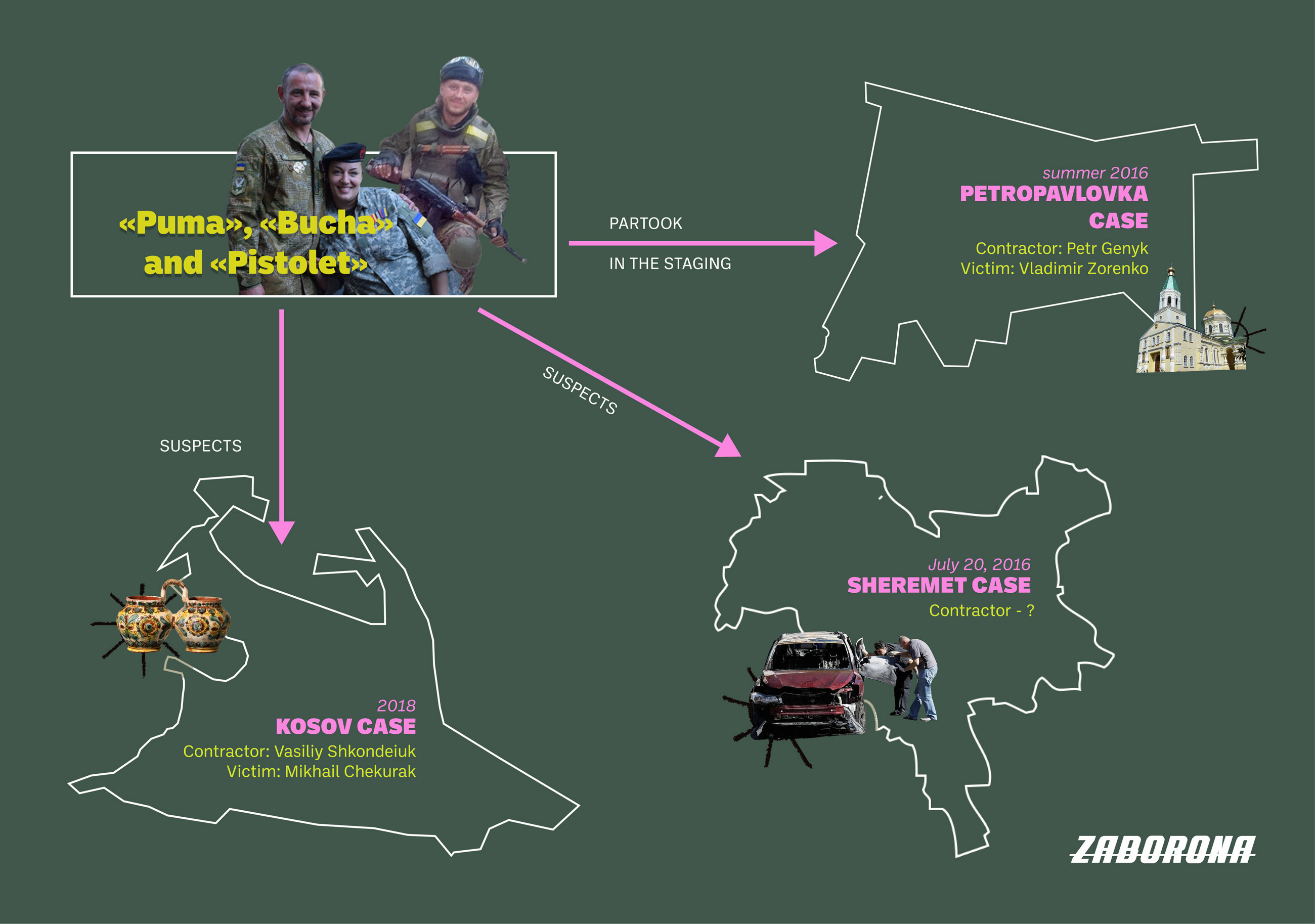
Disturbing audio recordings
During a briefing on December 12, 2019, the police showed recordings of Inna Gryshchenko’s telephone conversations. At one of them, she received a call from a veteran of the Russian-Ukrainian war and a close acquaintance, Ivan Vakulenko, nicknamed “Pistol”. In the conversation, it was about the fact that “Pistol” was summoned for interrogation in the Sheremet case, which caused Vakulenko a great concern. The interrogation was supposed to take place four days later, but two days before that Vakulenko was found dead in his parents’ apartment with a bullet in his head. The police said he shot himself.
Why was the summons concerning the murder of Pavel Sheremet so alarming for the late “Pistol” and why did he immediately call Inna Gryshchenko? She did not allow her answer to be published verbatim, but explained that at the moment of being summoned for interrogation, Pistol had a series of everyday problems that he could not solve, and the summons for interrogation could have been the last straw for him. In addition, “Puma” told Zaborona that before the call, Vakulenko “firstly rushed” to her house to inform her about the summons for interrogation, but then for some reason called her again on the same occasion. In the records of the conversation with “Bucha” published by the police, she tells him that she believes that Vakulenko shot himself. Now, in a conversation with Zaborona, she says the opposite: that he was “helped”.
Inna Gryshchenko calls the audio recordings published by the police edited and does not agree that she or Pistol had anything to do with the murder of Pavel Sheremet.
But there is another audio recording that mentions the late Ivan Vakulenko. This audio recording was published by an escaped official from the team of the former President of Ukraine Viktor Yanukovych – Andriy Portnov. After Vladimir Zelensky became president, he returned to Ukraine and speaks publicly with anti-Ukrainian rhetoric. We don’t trust his publications, so we checked the recordings. Portnov assures that the voices of Vladyslav Gryshchenko and an employee of the SBU Andriy Omelchenko are presented on the audio recording. Portnov calls him an employee of the fifth department of the counterintelligence department of the SBU, although there is no such information in the public domain about him.
On the recording, Omelchenko inquires from “Bucha” if the police have something about Sheremet’s case against him or about Inna. Vladislav replies no, but adds that the police found something on the late Ivan Vakulenko: “They have something on Vanya. That Vanya rented a car with a tracker and his phone was switched on and he went there,” says a voice similar to Vladyslav Gryshchenko on the audio recording. The episode he describes is actually about the assassination attempt in Kosiv, not the Sheremet case. It was for a trip to Kosiv that Vakulenko rented a car, not knowing that a tracker was built into it.
We checked Vladyslav Gryshchenko’s phone records, available in the criminal case of Pavel Sheremet, and found calls from numbers that belong to Andriy Omelchenko, which means that such a conversation could really have taken place. Now these numbers are not answered.
“Bucha” publicly denied knowing Omelchenko. However, both he and Puma called him periodically throughout 2016. Of those billing systems that are at the disposal of the editorial office, Vladyslav Gryshchenko spoke with an SBU officer on May 10, June 26, July 1 and 27, August 13 and 14, and September 9, several times a day.
Interestingly, Omelchenko is not just an ordinary SBU officer. In the fall of 2014, he was in the high rank of lieutenant colonel of the SBU, and the President of Ukraine Petro Poroshenko awarded him a medal for military service. In September 2020, Omelchenko resigned from the SBU with the rank of colonel. Inna Gryshchenko told us that she knew him even before Maidan “through his work in Lukyanovska prison”, where, in her opinion, he “worked with information in the penitentiary system.” Answering Zaborona’s question, Inna Gryshchenko admitted that her husband could have communicated with Omelchenko during this period, but added that he met this SBU officer without her participation.
The SBU has already featured in the investigations into the Sheremet case. At first, colleagues from the Slidstvo.info agency of investigative journalism found out that a former (and according to some reports – not a former) officer of the Alpha special forces of the SBU was monitoring the journalist’s house on the eve of the murder. At this time, around midnight, an unknown person was hanging around the journalist’s car. Later, screenshots of the correspondence between the former representative of the Donbas battalion Vasylisa Mazurchuk (and the friend of the suspect in the Sheremet case, Yulia Kuzmenko) and the press secretary of the Ministry of Internal Affairs Artem Shevchenko, in which he accused the SBU counterintelligence, were published. In a conversation with Zaborona, Shevchenko said that the authenticity of the screenshot has not been proven. However, we received confirmation from Shevchenko’s interlocutor and are convinced of the authenticity of the correspondence.
The nature of the wiretapping is also interesting. Today, only the SBU can listen to citizens. It is this special service that controls the equipment, explains Olena Shcherban, deputy executive director of the Anti-Corruption Center, although under the new laws this right was granted to the National Anti-Corruption Bureau, the State Bureau of Investigation, and the police.
“Contrary to the will of the legislator, the SBU does not want to lose its influence and exclusive rights and blocks the exercise of this right by other bodies – it does not give actual access and does not change its regulatory documents,” says Shcherban. “The reason for blocking is simple and obvious: the service wants to control and know who is being tapped by other law enforcement officers. The media have repeatedly reported that the SBU is often actually trading this information. In addition, this is how the special services protect themselves – after all, they have the ability to control wiretapping on them.”
